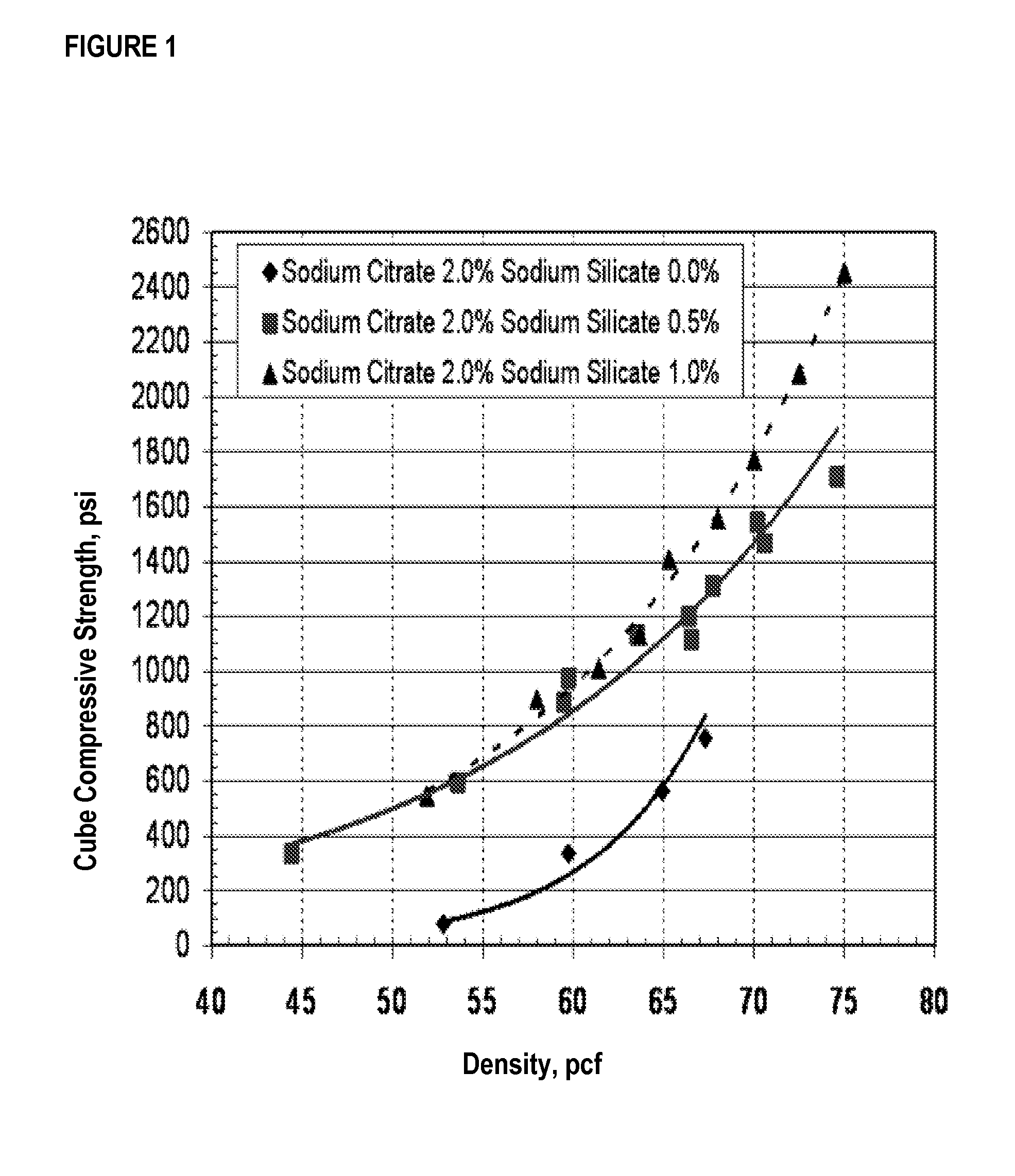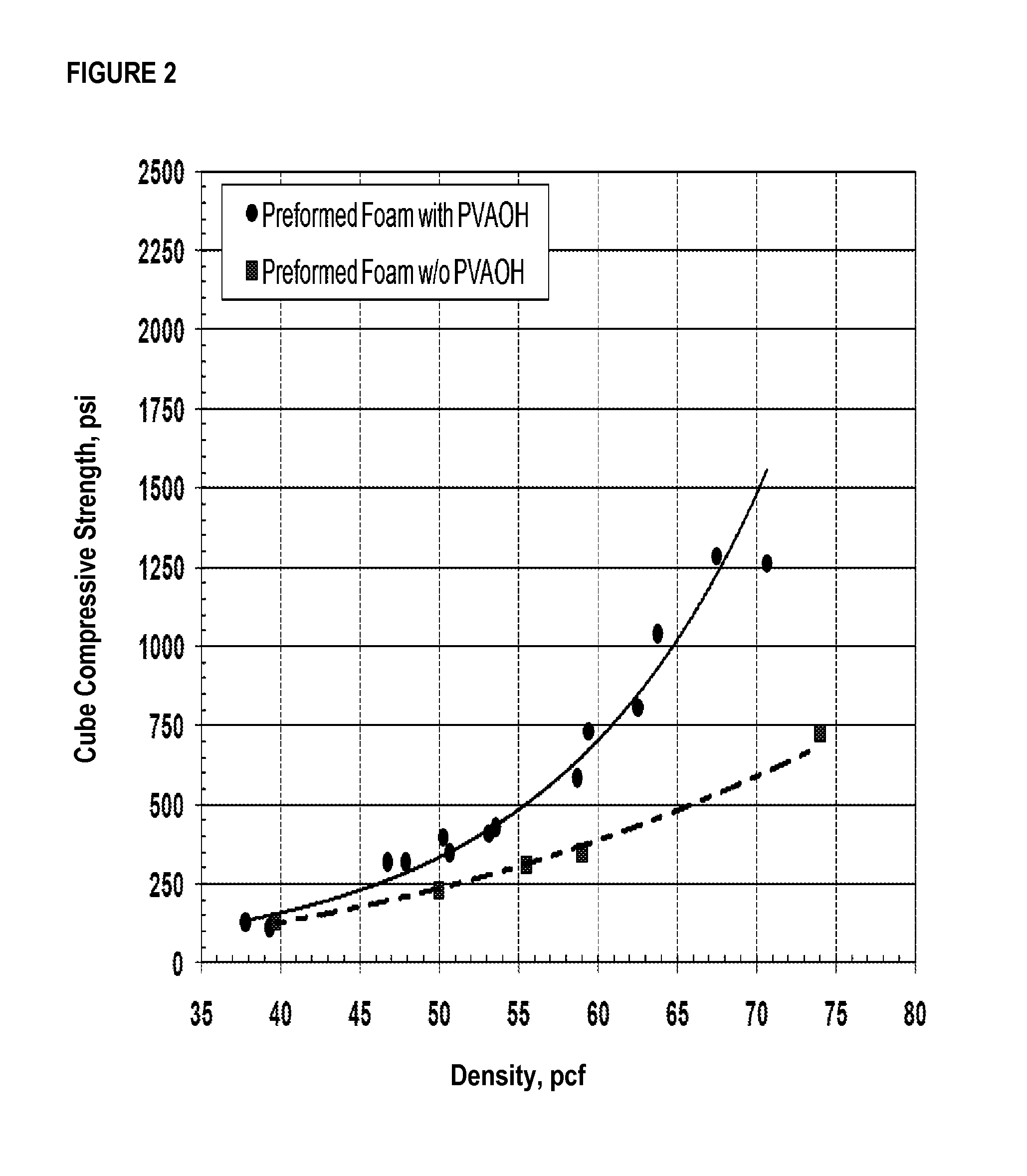Lightweight foamed fly ash based binders and method
a technology of fly ash and binders, which is applied in the direction of sealing/packing, solid waste management, and well accessories, etc., can solve the problems of galer et al's rapid setting formulation suffering from several limitations, foam collapsing and/or drastic strength reduction, etc., and achieves excellent moisture durability, high compressive strength, and high carbon footprint
- Summary
- Abstract
- Description
- Claims
- Application Information
AI Technical Summary
Benefits of technology
Problems solved by technology
Method used
Image
Examples
example 1
(Mixes 1-17)—In Situ Mixing Procedure
[0119]Sodium silicate is first added to water and dissolved, then sodium citrate is added to the solution and dissolve. The soap foaming agent is then added to the solution of sodium silicate / and sodium citrate. The resulting aqueous solution of sodium silicate, sodium citrate and soap is then added to Class C fly ash reactive powder and mixed in a Hobart mixer at medium speed. After about 40 seconds the mixer speed is increased (speed #3) and mixing is continued for a total of up to 4-6 minutes.
[0120]A solution containing 2.5 to 8.0% sodium silicate, 15 to 35% sodium citrate is made stirring until all the sodium silicate first and then the sodium citrate has been dissolved. To this solution 3-6% foaming agent is added. Upon this addition the viscosity of the sodium citrate solution increases significantly indicating a synergistic interaction between the sodium citrate and the foaming agent. The surfactant used was an alpha olefin sulfonate (AOS)...
example 2
Mixing Procedure for Ex-Situ Foams
[0126]Mixing Procedure (Ex-Situ Foams)
[0127]A PVOH solution (concentration 2 to 5%) is first prepared using warm water (50 to 80 C) until PVOH is completely dissolved. The solution is allowed to reach to room temperature and then the surfactant soap (8% soap solution) is added and foamed prior to blending with fly ash / sodium citrate / water slurry using standard mixing procedures. For this example sodium silicate was not added and the main goal was to determine the influence of PVOH on foam fly ash binders using ex-situ foams. The surfactant used was an alpha olefin sulfonate (AOS) soap brand name Witconate AOS from Akzo Nobel. The PVOH used was CELVOL 205-S from Scksui Specialty Chemical America LLC, Scksui Chemical Company Ltd.
[0128]Formulations for Example #2 using a soap solution plus foaming agent with PVOH are included in Table 2-1 and formulations for Example #2 using 4% soap solution plus foaming agent without PVOH are included in Table 2-1. T...
example 3
Mixtures Made Using Class F Fly Ash
[0131]The previous experiments concentrated on the use of class C fly ash as the main cementitious binder in combination with sodium or potassium citrate, since preliminary results with class F fly ash indicated relatively lower compressive strength of class F fly ash binders compared to similar formulations with class C fly ash. Since it is commercially desirable to be able to use either type of fly ash depending on the local sources of coal being used. It is well known and chemical analysis showed that the main difference in the chemical composition between the class C and class F fly ash is the higher lime content for the class C relative to the class F fly ash (20% versus 10%).
[0132]For this example the mixtures included the following components:
[0133]Component A=Class F Fly Ash
[0134]Component B=Type III PC
[0135]Component C=Water
[0136]Process Variable X=Sodium citrate
[0137]The lower and upper bounds for the amounts of each of the mixture compon...
PUM
| Property | Measurement | Unit |
|---|---|---|
| weight ratio | aaaaa | aaaaa |
| compressive strength | aaaaa | aaaaa |
| density | aaaaa | aaaaa |
Abstract
Description
Claims
Application Information
 Login to View More
Login to View More - R&D
- Intellectual Property
- Life Sciences
- Materials
- Tech Scout
- Unparalleled Data Quality
- Higher Quality Content
- 60% Fewer Hallucinations
Browse by: Latest US Patents, China's latest patents, Technical Efficacy Thesaurus, Application Domain, Technology Topic, Popular Technical Reports.
© 2025 PatSnap. All rights reserved.Legal|Privacy policy|Modern Slavery Act Transparency Statement|Sitemap|About US| Contact US: help@patsnap.com


